Enjoy DatePsychology? Consider subscribing at Patreon to support the project.
As the dating discourse ebbs and flows, I have noticed an uptick of discussion on my timeline regarding a male desire for virgin partners. However, outside of the young and religious demographic, virginity is uncommon. In the past I have written about what percentage of men remain virgins: it’s pretty small (see: Are 27% Of Young Men Really Virgins?).
Recently, I collected data on preferences for past partners, colloquially called “body count.” In this article I will present some of this data to answer the question.
Methodology
The subgroup from this dataset consists of 512 heterosexual men between 18-74 years old. The mean is 33 years old with a standard deviation of 9 years.
For variables considered in this analysis, I asked participants to give their preferred or ideal number of past sexual partners in a committed relationship with a romantic partner. They were also able to indicate that they had “no ideal” number.
I asked participants to rate the importance of past partner count on a 1-7 Likert scale, their desire for a monogamous relationship on a 1-7 scale, and their political ideology on a 1-7 scale from left to right.
I also asked for relationship and sexual history status and level of education.
Results
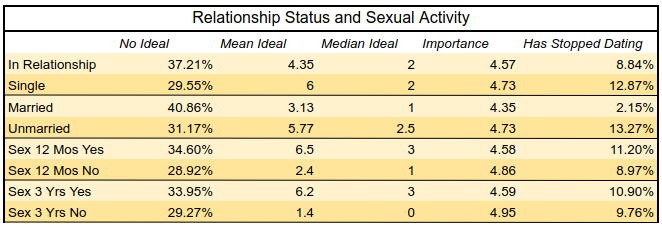
Here are the values for relationship status and sexual activity history. Men who were married, in committed relationships, and sexually active were less likely to have an ideal past partner count for a romantic partner. Married men and men in committed relationships were also less likely to report that they stopped dating someone due to a high past partner count. Importance ratings for past partner count were similar across groups; 4 was average on the scale.
Men who were not sexually active in the past three years or the past 12 months also had a lower median ideal. Who really wants a virgin across these groups? Mostly, men who have been without sex for an extended period of time.

Participants who were themselves virgins, or participants who had no past sexual partners, were more likely to report that they had an ideal past partner preference and reported a lower ideal. The median for this group was 0. Virgin men wanted virgin women, basically.
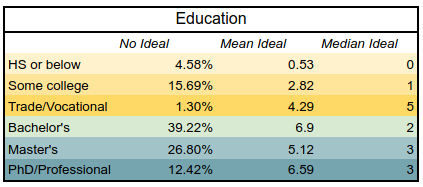
This table shows past partner preferences by educational attainment. Men who had lower educational attainment were more likely to report that they had an ideal. They were also more likely to report a lower number for an ideal partner, with the exception of individuals with a trade or vocational background. For the highest educated participants, the trend reversed for having an ideal preference.
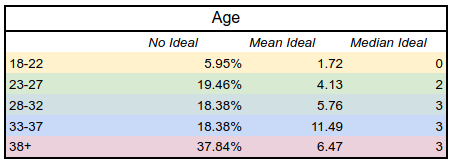
Above are breakdowns for past partner preferences by age group. The youngest men were the most likely to report that they did have an ideal number. They were also the most likely to report that the mean and the median was low. In other words, the youngest men wanted virgins.

Politics was a good predictor of who wanted a virgin partner. Men who identified as left of center were more likely to report a higher ideal and report that they had no ideal. Men who were centrist or conservative were more likely to report that they did have an ideal and that the ideal was a lower number.

Perhaps an unexpected result here: the men who had the highest desire for monogamy were the least likely to report that they had an ideal past partner preference. The mean ideal partner number is much higher for the low desire for monogamy group (likely reflecting some non-monogamists in the sample).
Conclusion
Who are the men who show a stronger preference for virginity in a romantic partner? Mostly, young men, conservative men, men who have been without sex for an extended period of time, and men who are themselves virgins.
It isn’t a shock, perhaps, that the youngest demographic prefers lower partner counts and virginity. It isn’t even an unreasonable expectation (although it becomes increasingly unreasonable with age, as age cohorts accumulate sexual experience).
A common belief is that men will have sex with women who have high partner counts, but won’t commit to them in relationships. The data here is not well suited to test that, but is also not consistent with this belief. Men who had the strongest desire for monogamy were also the least likely to report that they had any ideal past sexual partner preference at all. Reported preferences for past partner count, or how important it was to the participants, were also moderate across groups.
The ideal number of past partners in a romantic partner was nonetheless relatively low. Fortunately, it is also low in the general population. The Center for Disease Control and Prevention (CDC) found that the median number of past sexual partners for women was 4.3. General Social Survey (GSS) data for 2021 and 2022 also indicate relatively low levels of promiscuity, with most sex occurring in monogamous relationships.
Although stated ideal preferences were low, I also examined behavioral reports.
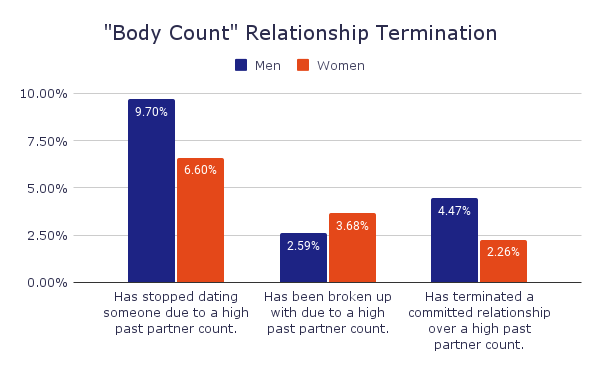
This chart shows the percentage of men and women who have broken up with someone during dating and who have terminated a committed relationship after learning a partner’s past sexual history. This is from a larger sample of 660 men and women.
These percentages are for participants who were not in the “no ideal” category, so the real number is substantially lower. Most people don’t seem to be terminating dates or relationships due to a partner’s revealed sexual history.
Further, the partner count must be substantially high for them to do so. I asked participants how many partners were revealed when they broke up. The average for men was 23 with a median of 17 and for women was 47.5 with a median of 40. In other words, this may only be a concern for the top 5% of the population in terms of promiscuity.
I also asked participants to report if they have been asked how many past sexual partners they have had by a committed romantic partner. 51.23% of men and 59.3% of women reported that they had never been asked. Additionally, 35% of both men and women reported that they didn’t know the past number of sexual partners of their current romantic partner.
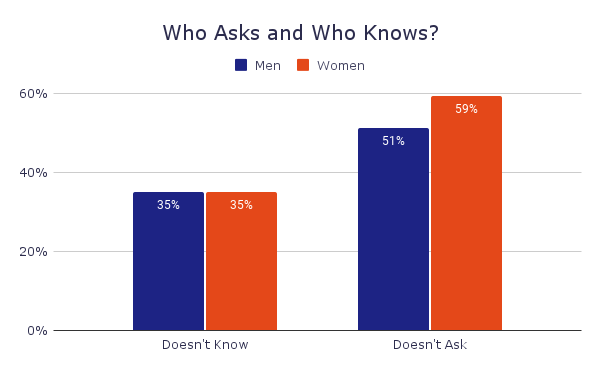
Men who did know reported that their current committed partner had an average of 9.85 past sexual partners, with a median of 4.5. Women reported that their male partners had an average of 14.6 past sexual partners, with a median of 3.
So, in this data we see relatively low levels of promiscuity consistent with representative statistics from the CDC and GSS.
Most people aren’t asking. A substantial minority don’t know. Of those who do know, their preferences tend to be in line with the actual partner count of their romantic partners. And relatively few people seem to demand virginity.